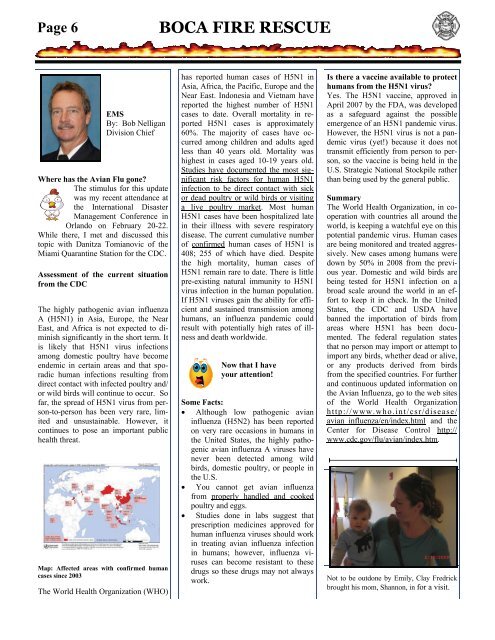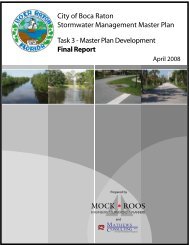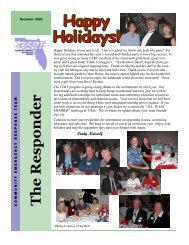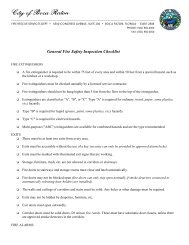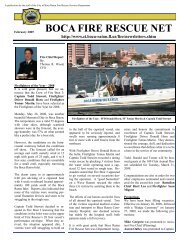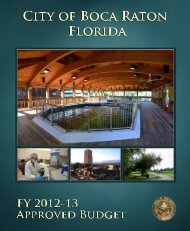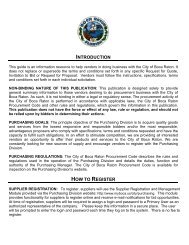BOCA FIRE RESCUE NET - City of Boca Raton
BOCA FIRE RESCUE NET - City of Boca Raton
BOCA FIRE RESCUE NET - City of Boca Raton
You also want an ePaper? Increase the reach of your titles
YUMPU automatically turns print PDFs into web optimized ePapers that Google loves.
Page 6<br />
<strong>BOCA</strong> <strong>FIRE</strong> <strong>RESCUE</strong><br />
EMS<br />
By: Bob Nelligan<br />
Division Chief<br />
Where has the Avian Flu gone?<br />
The stimulus for this update<br />
was my recent attendance at<br />
the International Disaster<br />
Management Conference in<br />
Orlando on February 20-22.<br />
While there, I met and discussed this<br />
topic with Danitza Tomianovic <strong>of</strong> the<br />
Miami Quarantine Station for the CDC.<br />
Assessment <strong>of</strong> the current situation<br />
from the CDC<br />
The highly pathogenic avian influenza<br />
A (H5N1) in Asia, Europe, the Near<br />
East, and Africa is not expected to diminish<br />
significantly in the short term. It<br />
is likely that H5N1 virus infections<br />
among domestic poultry have become<br />
endemic in certain areas and that sporadic<br />
human infections resulting from<br />
direct contact with infected poultry and/<br />
or wild birds will continue to occur. So<br />
far, the spread <strong>of</strong> H5N1 virus from person-to-person<br />
has been very rare, limited<br />
and unsustainable. However, it<br />
continues to pose an important public<br />
health threat.<br />
Map: Affected areas with confirmed human<br />
cases since 2003<br />
The World Health Organization (WHO)<br />
has reported human cases <strong>of</strong> H5N1 in<br />
Asia, Africa, the Pacific, Europe and the<br />
Near East. Indonesia and Vietnam have<br />
reported the highest number <strong>of</strong> H5N1<br />
cases to date. Overall mortality in reported<br />
H5N1 cases is approximately<br />
60%. The majority <strong>of</strong> cases have occurred<br />
among children and adults aged<br />
less than 40 years old. Mortality was<br />
highest in cases aged 10-19 years old.<br />
Studies have documented the most significant<br />
risk factors for human H5N1<br />
infection to be direct contact with sick<br />
or dead poultry or wild birds or visiting<br />
a live poultry market. Most human<br />
H5N1 cases have been hospitalized late<br />
in their illness with severe respiratory<br />
disease. The current cumulative number<br />
<strong>of</strong> confirmed human cases <strong>of</strong> H5N1 is<br />
408; 255 <strong>of</strong> which have died. Despite<br />
the high mortality, human cases <strong>of</strong><br />
H5N1 remain rare to date. There is little<br />
pre-existing natural immunity to H5N1<br />
virus infection in the human population.<br />
If H5N1 viruses gain the ability for efficient<br />
and sustained transmission among<br />
humans, an influenza pandemic could<br />
result with potentially high rates <strong>of</strong> illness<br />
and death worldwide.<br />
Now that I have<br />
your attention!<br />
Some Facts:<br />
• Although low pathogenic avian<br />
influenza (H5N2) has been reported<br />
on very rare occasions in humans in<br />
the United States, the highly pathogenic<br />
avian influenza A viruses have<br />
never been detected among wild<br />
birds, domestic poultry, or people in<br />
the U.S.<br />
• You cannot get avian influenza<br />
from properly handled and cooked<br />
poultry and eggs.<br />
• Studies done in labs suggest that<br />
prescription medicines approved for<br />
human influenza viruses should work<br />
in treating avian influenza infection<br />
in humans; however, influenza viruses<br />
can become resistant to these<br />
drugs so these drugs may not always<br />
work.<br />
Is there a vaccine available to protect<br />
humans from the H5N1 virus?<br />
Yes. The H5N1 vaccine, approved in<br />
April 2007 by the FDA, was developed<br />
as a safeguard against the possible<br />
emergence <strong>of</strong> an H5N1 pandemic virus.<br />
However, the H5N1 virus is not a pandemic<br />
virus (yet!) because it does not<br />
transmit efficiently from person to person,<br />
so the vaccine is being held in the<br />
U.S. Strategic National Stockpile rather<br />
than being used by the general public.<br />
Summary<br />
The World Health Organization, in cooperation<br />
with countries all around the<br />
world, is keeping a watchful eye on this<br />
potential pandemic virus. Human cases<br />
are being monitored and treated aggressively.<br />
New cases among humans were<br />
down by 50% in 2008 from the previous<br />
year. Domestic and wild birds are<br />
being tested for H5N1 infection on a<br />
broad scale around the world in an effort<br />
to keep it in check. In the United<br />
States, the CDC and USDA have<br />
banned the importation <strong>of</strong> birds from<br />
areas where H5N1 has been documented.<br />
The federal regulation states<br />
that no person may import or attempt to<br />
import any birds, whether dead or alive,<br />
or any products derived from birds<br />
from the specified countries. For further<br />
and continuous updated information on<br />
the Avian Influenza, go to the web sites<br />
<strong>of</strong> the World Health Organization<br />
http://www.who.int/csr/disease/<br />
avian_influenza/en/index.html and the<br />
Center for Disease Control http://<br />
www.cdc.gov/flu/avian/index.htm.<br />
Not to be outdone by Emily, Clay Fredrick<br />
brought his mom, Shannon, in for a visit.


